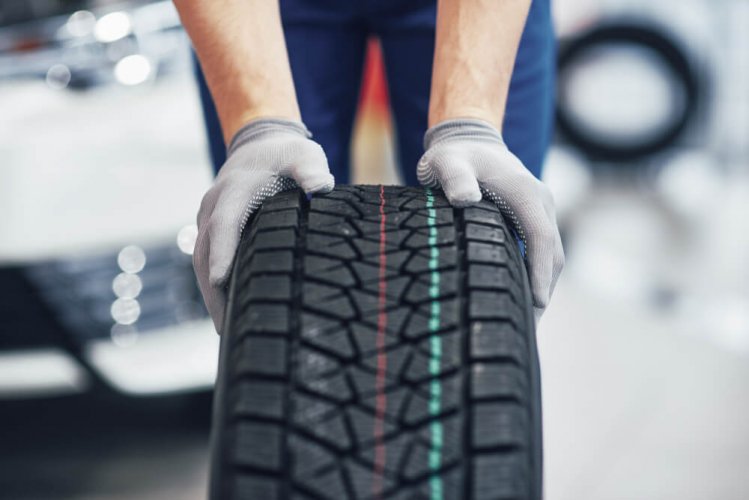
Combine these essential tire care tips with a solid tire hazard protection plan and you’ll be good to set out on the road trip of your dreams.
1. Don’t Buy Cheap Tires
Countless people ask, “are cheap tires dangerous?” The answer is a resounding “yes.”
Cheap tires tend to have a longer braking distance and poor traction performance on ice and snow. They are also extremely loud and don’t last as long as more expensive ones. Quality brands often last three times longer than cheap choices, so you will actually lose money in the long run if you buy the most inexpensive ones you find.
2. Don’t Drive on Worn Tires
Next, you might wonder, “how dangerous are worn tires?” They are incredibly dangerous, even when at half-tread. Consumer Reports tested worn tires, and the results were stunning. They are more likely to hydroplane, and it takes them longer to stop in bad weather. They also have low traction in the snow.
A tire’s tread isn’t just a safety concern—it’s also a matter of fuel efficiency. Driving on worn down tires reduces your fuel economy because it adds to your vehicle’s resistance, i.e., how much effort it takes for your vehicle to physically move itself.
Wondering whether your tire tread passes the test? Some tires have built-in tread wear indicators. These come in the form of wear bears that are built into tire grooves. Once the wear bars have worn down, you know that it’s time to replace your tire.
Another way to test your tire tread depth is with the penny test. To perform the penny test, you should take a U.S. penny and position it so that the “heads” side is facing you. Turn the penny upside down so that the head is pointing towards the ground. Stick the penny in the rib of your tire. If you can see Lincoln’s entire head, then your tires are likely worn down and in need of replacement.
3. Replace Old Tires
Your tires are getting up there in age, and you want to know, “are old tires safe?” You should replace old tires, even if they still have deep tread depths. Old tires can wear down, impacting handling and drivability. The tread can even separate from the tire when it’s too old. As a general rule, a good schedule for replacing your tires is every six years (even if they still look like they’re in good shape).
You don’t need to necessarily replace your tires with new tires every time. But if you’re buying tires secondhand, be sure to do your due diligence to make sure they’re free of wear issues and other various damages.
4. Know How to Change a Tire
It’s a good idea to know how to change a tire, even if you have roadside assistance. Let’s go through the steps:
-
Make sure your vehicle is secure, and then remove the wheel cover. Use a wrench to loosen the lug nuts and jack up the car so it’s approximately 6 inches off the pavement.
-
Remove the tire you need to change by taking off its lug nuts. A lug nut is the fastener that is used to attach your tire to your car.
-
Put the spare tire on the lug nut posts and replace the lug nuts. Don’t fully tighten the lug nuts until you lower your vehicle.
-
Tighten the lug nuts and put the wheel cover back on the hubcap, and you’re ready to drive.
After people see you do this a few times, you might become the resident tire changer. It’s a great skill to have, and you’re sure to impress your friends.
If you’re driving on a donut-style spare tire, remember that tires of this type are designed to get you to the closest repair shop. You should not drive fast or far on a spare tire.
5. Check Your Tire Pressure Monthly
Under-inflated tires are dangerous, so check your tire air pressure each month as part of your tire care routine. Start by finding the recommended proper pressure for your car in your vehicle’s owner’s manual (ideal tire pressure may also be indicated on the interior of your car doors).
Next, take the valve cap off your tire and use a tire pressure gauge to check the pressure of your tires. If you don’t already have a tire gauge, you can pick one up for as low as $5 at your local auto parts shop — it’s a good investment.
If your tires are underinflated, add air and check again. Then, add or remove air as needed until you reach the guidelines set out for your car’s tire pressure.
6. Invest in Routine Tire Rotations and Alignments
Tire rotation refers to the act of moving tires around from one side of a vehicle to another. Proper tire rotation schedules prevent uneven tire wear and is an important part of overall tire maintenance. Out-of-balance tires make a car harder to steer and not only prevent you from an overall comfortable ride but also put you more at risk for accidents.
Wheel alignment, on the other hand, refers to the act of adjusting your car’s suspension to make sure that your tires are pointing in the right direction. Proper alignment not only gives you accurate control over the direction of your vehicle but also helps prolong the life of your tires by preventing irregular tire wear.
7. Consider Winter Tires
If you live in a cold climate, you should look into purchasing snow tires. While they may not be required by law in your area, they can provide a safer and smoother ride during the most dangerous driving months of the year.
Contrary to popular belief, winter tires do not just work on snow but on all slippery surfaces caused by freezing temperatures. So, even if you don’t receive a lot of snowfall in your area, you may still be able to get some use out of snow tires. They come with extra treads that allow them to grip more effectively to the road surface.
In order to get the most out of your snow tires, you should pay attention to how you store them. Store them in a cool, dry environment that’s away from direct sunlight. Winter tires take up a lot of room, so if you live in an apartment or small house you might need to pay to have your tires stored at a local garage.
8. Make Sure Your Tires are Balanced
Tire balancing is similar to tire alignment, but not quite the same thing. While alignment is concerned about the angle of your tire suspension, balancing is concerned with the angle that your tires meet the road. You’ll notice that you have much better vehicle performance when your tires are balanced because it will eliminate uncomfortable vibrations caused by imbalanced tires. This will help prevent you from encountering instability when you hit those high speeds.
9. Make Inspecting Your Tires a Habit
Even if you don’t fancy yourself a car expert of any kind, you should still make it a point to visually inspect your tires on a regular basis. Taking a moment to have a look at your tires can help you spot abnormal tire wear before it becomes a serious problem.
To perform a visual tire inspection, walk the perimeter of your vehicle so you get a good look at all four tires. Even if you don’t have time to perform a test to check for tire tread or tire pressure, you can make sure that you don’t see any nails, screws or other debris stuck in your tires.
10. Follow Vehicle Manufacturer Recommendations
There are some things in life where instinct isn’t enough. When it comes to taking care of your tires, don’t follow your intuition. Instead, follow the best practices recommended by your vehicle manufacturer. Every vehicle manufacturer provides its customers with maintenance schedules for important components like brakes, engines, transmissions, steering, and of course, tires. Manufacturer recommendations are more than just suggestions — you should follow them as closely as you can.
Be a Responsible Vehicle Owner With Auto Insurance
Use these tips to establish how you will take care of your tires. Although it’s not the only part of your vehicle that you have to keep your eyes on, it’s definitely one that can have a positive impact on your overall driving experience.
You can also get help with tire care by adding roadside assistance to your car insurance policy. Then, you can call for help if something happens to one of your tires.
Freeway Insurance can help you take care of your car the right way. Start with big savings on coverage with a free auto insurance quote and complement it with a tire hazard protection plan. Contact us today at (800) 777-5620 or find a Freeway Insurance office near you.


